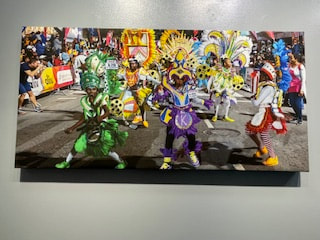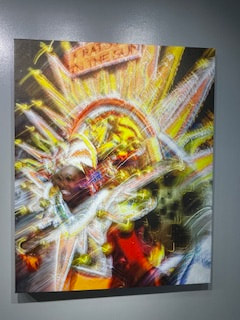
This trip took place during the Easter Holiday which meant schools (K-12) were on Spring Break and Friday (Good Friday) and Monday (Easter Monday) were holidays. This also meant that it was a short work week, some things may not get done, and some people may not be on the island. Surprisingly, I got a lot accomplished.
Day 1: I arrived on Monday in the midst of the Spring Break rush, so it took a minute to clear customs and immigration. As I am waiting, I noticed there was no music playing; I was disappointed. Where was the local entertainment whose purpose is to provide the tourists with a taste of our native sound and culture? As time passed, I did hear something over in that corner where they were set up, but it wasn’t consistent; maybe they were warming up.
Day 2: The Town Hall (the main purpose of my trip) was a success. I shared my research, discussed what the data revealed, expressed my thoughts on the needs of the community and the state of dance in the country, and then facilitated a fruitful discussion.
Day 3: I took care of some banking needs earlier that morning, then I made my way downtown to The Central Bank of the Bahamas to see the “Junkanoo Colours: Inside the Shack” photography exhibit by Douglas Barkey and Leader of Colours Junkanoo Group, Christian Justilien and group members. To provide some historical context, “The Central Bank of The Bahamas was established on 1st June 1974, to carry out the independent monetary policy and financial sector supervisory functions entrusted upon The Bahamas after political independence from Great Britain in 1973. This need for an alternative institutional arrangement with statutory powers became even more apparent amid the turbulent developments in global financial markets, marked by the 1967 devaluation of the Pound Sterling, to which the local currency was linked. Based on the emerging strong trade linkages with the United States, the Government de-linked the Bahamian dollar (formerly the pound) from its peg with the Pound Sterling, and established the currency on par with the United States' dollar” (https://www.centralbankbahamas.com/our-history”.
As I walked upstairs to view the exhibit, I was immediately drawn in by the crisp sharp colors as well as the abstraction of some of the images which forced you to hone in on the possibilities. I loved the multigenerational component of the group; young men and women of all ages were participants, whether as a musician or a dancer. The kids were smiling and focused on what they were doing. There was a sense of purpose and integrity captured in the images. Barkey states that, “Every photograph in this exhibit is a play on the meaning of the word, “colour” and the colours of Junkanoo. Color is more than pigmentation, it is also the nuance of personality, the style of sound, the smells of street food—the character of celebration” (Barkey 2022).
He's interested in capturing the raw behind the scenes elements of the shack and the diverse ways the members prepare for the ultimate performance on Bay. He investigates the unseen moments that aide in the wonderment of that “actual final performance” (Barkey 2022). As I thought about these words, I wanted to move through the space. I walked around the exhibit and imagined hearing the powerful drums playing and the sound of the horns moving my body up and down the thin pathway in the bank. I visualized my legs shifting side to side as my hips dropped to the earth rotating in small circles then gradually increasing creating a tsunami of waves. My arms would gather the energy of Oya’s power and send it around my body, rhythmically turning, carving, and cutting through the space, flinging limbs around effortlessly.
After this experience, I treated myself to a Fried Fish (snapper) dinner with peas n rice, macaroni and cheese, and coleslaw from Twin Brothers on Arawak Cay (Fish Fry). I also ordered conch salad and a Sands Pink Radler beer to seal the deal.
Day 4: This day was filled with back-to-back meetings at the University of the Bahamas. I also had the opportunity to observe Shauné Culmer’s dance class that afternoon. Later that day, I grabbed an early dinner with my dancing buddy from high school and ended the day preparing for my post on Bahamian Women Dancer’s.
Day 5. Good Friday. I went on a tour of the Colours Junkanoo Shack to see where all the magic happens; I also tried on a few costumes!
Day 6: Headed home to work more…
Image 1: Town Hall Meeting attendees
Image 2: Students from Shaune Culmer's Dance Class
Image 3: Students from Shaune Culmer's Dance Class
Image 4-10: Junkanoo Colours Exhibit
Image 11-13: Colours Junkanoo Shack Tour
Day 1: I arrived on Monday in the midst of the Spring Break rush, so it took a minute to clear customs and immigration. As I am waiting, I noticed there was no music playing; I was disappointed. Where was the local entertainment whose purpose is to provide the tourists with a taste of our native sound and culture? As time passed, I did hear something over in that corner where they were set up, but it wasn’t consistent; maybe they were warming up.
Day 2: The Town Hall (the main purpose of my trip) was a success. I shared my research, discussed what the data revealed, expressed my thoughts on the needs of the community and the state of dance in the country, and then facilitated a fruitful discussion.
Day 3: I took care of some banking needs earlier that morning, then I made my way downtown to The Central Bank of the Bahamas to see the “Junkanoo Colours: Inside the Shack” photography exhibit by Douglas Barkey and Leader of Colours Junkanoo Group, Christian Justilien and group members. To provide some historical context, “The Central Bank of The Bahamas was established on 1st June 1974, to carry out the independent monetary policy and financial sector supervisory functions entrusted upon The Bahamas after political independence from Great Britain in 1973. This need for an alternative institutional arrangement with statutory powers became even more apparent amid the turbulent developments in global financial markets, marked by the 1967 devaluation of the Pound Sterling, to which the local currency was linked. Based on the emerging strong trade linkages with the United States, the Government de-linked the Bahamian dollar (formerly the pound) from its peg with the Pound Sterling, and established the currency on par with the United States' dollar” (https://www.centralbankbahamas.com/our-history”.
As I walked upstairs to view the exhibit, I was immediately drawn in by the crisp sharp colors as well as the abstraction of some of the images which forced you to hone in on the possibilities. I loved the multigenerational component of the group; young men and women of all ages were participants, whether as a musician or a dancer. The kids were smiling and focused on what they were doing. There was a sense of purpose and integrity captured in the images. Barkey states that, “Every photograph in this exhibit is a play on the meaning of the word, “colour” and the colours of Junkanoo. Color is more than pigmentation, it is also the nuance of personality, the style of sound, the smells of street food—the character of celebration” (Barkey 2022).
He's interested in capturing the raw behind the scenes elements of the shack and the diverse ways the members prepare for the ultimate performance on Bay. He investigates the unseen moments that aide in the wonderment of that “actual final performance” (Barkey 2022). As I thought about these words, I wanted to move through the space. I walked around the exhibit and imagined hearing the powerful drums playing and the sound of the horns moving my body up and down the thin pathway in the bank. I visualized my legs shifting side to side as my hips dropped to the earth rotating in small circles then gradually increasing creating a tsunami of waves. My arms would gather the energy of Oya’s power and send it around my body, rhythmically turning, carving, and cutting through the space, flinging limbs around effortlessly.
After this experience, I treated myself to a Fried Fish (snapper) dinner with peas n rice, macaroni and cheese, and coleslaw from Twin Brothers on Arawak Cay (Fish Fry). I also ordered conch salad and a Sands Pink Radler beer to seal the deal.
Day 4: This day was filled with back-to-back meetings at the University of the Bahamas. I also had the opportunity to observe Shauné Culmer’s dance class that afternoon. Later that day, I grabbed an early dinner with my dancing buddy from high school and ended the day preparing for my post on Bahamian Women Dancer’s.
Day 5. Good Friday. I went on a tour of the Colours Junkanoo Shack to see where all the magic happens; I also tried on a few costumes!
Day 6: Headed home to work more…
Image 1: Town Hall Meeting attendees
Image 2: Students from Shaune Culmer's Dance Class
Image 3: Students from Shaune Culmer's Dance Class
Image 4-10: Junkanoo Colours Exhibit
Image 11-13: Colours Junkanoo Shack Tour














 RSS Feed
RSS Feed